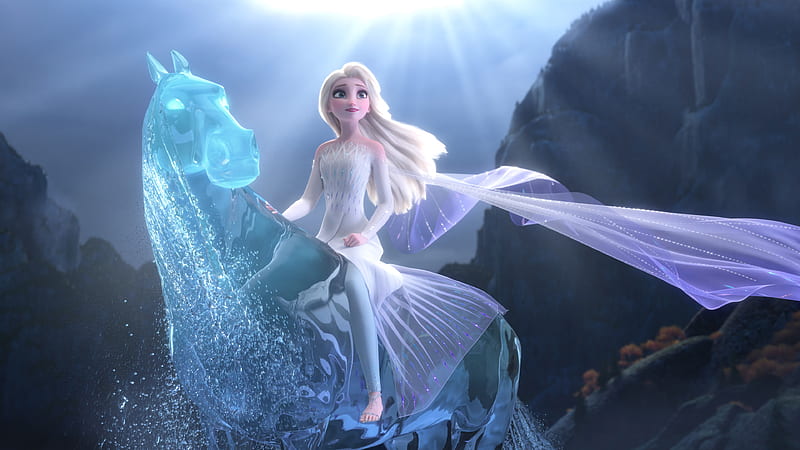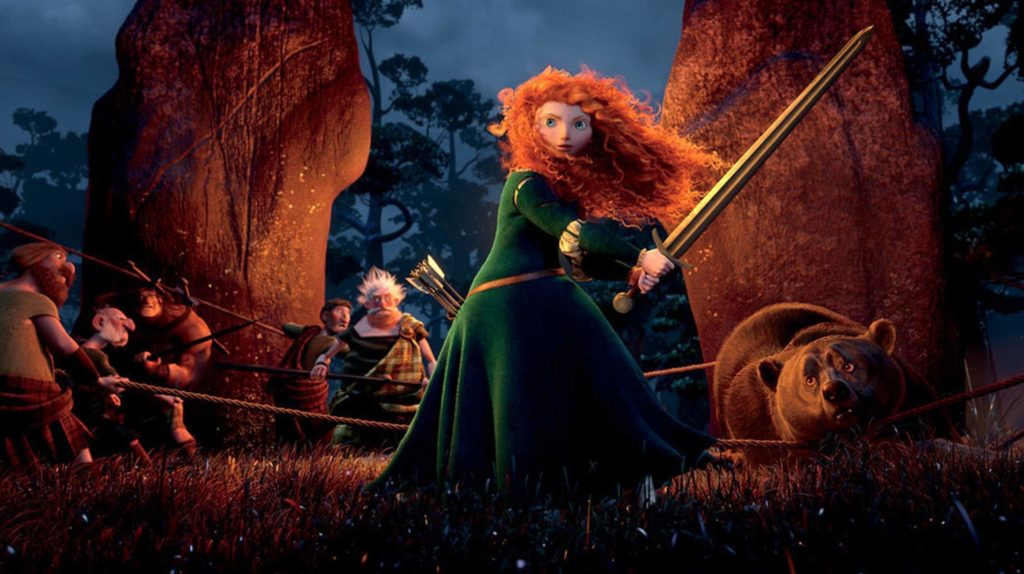Trans Allegories in Film: 'Nimona' (2023)
Animation as a medium of storytelling can be thought to be open to all ages and as I hope my reading will reveal, 'Nimona' could be interpreted as a transgender story.
Disney can and has to do better in supporting the LGBTQIA+ community. The sense of support and representation for the aroace community I discuss in this article are entirely hypothetical. Aroace is shorthand for aromantic and asexual (the spelling is different because ace is based on pronunciation). These readings are meaningful for fans on the asexual spectrum (referred to as A-spec) who notice similarities and feel seen by the presence of these characters. Maybe they are intentionally coded to represent the aroace community, but there’s no official canon presence of any character on the A-spec in Disney films. In fact, Disney’s first canonically queer character in an animated feature film only came last year with Strange World.
Broadly speaking, aromantic individuals are people who either do not feel romantic attraction at all or at least not in the traditional sense. Shift the context from romantic to sexual attraction and you have asexual people. The A-spec is a spectrum on which individuals experience different degrees of romantic and sexual attraction. Like any label, it can be individually defined by those who identify as aromantic, asexual, or as being on the aroace spectrum. It is also important to mention that while Disney as an organization hasn’t always been the best ally of the LGBTQIA+ community (think of the “don’t say gay” bill controversy), its content has resonated with queer people for a long time because many famous and iconic characters are queer-coded since directors, songwriters, and other creatives were often queer individuals themselves and intentionally coded some of the characters they created.

As promised in an earlier article, here’s all my evidence pointing to Elsa’s existence on the A-spec. Both in Frozen and Frozen II, Queen Elsa has no romantic relationships with any character. This may not seem to be indicative of Elsa’s identity, but this is Frozen we’re talking about. Romance plays a big part in the plots of both the films in the duology. The focus is the sisterhood between Elsa and Anna, sure, but the central conflict in Frozen is instigated by a romantic dynamic between Anna and Prince Hans, who she meets and decides to marry on the same day. The romance in Frozen II is less central to the plot, but the subplot involving the romantic dynamic between Anna and her boyfriend, Kristoff, is treated as significant. Not only that, but it’s a film by Disney. They once made two seemingly gender-less robots male and female and gave them a kiss! I’m referring to the Pixar film Wall-e. So narratives with no romantic dynamic in the protagonist’s life are a rarity in Disney films. Despite that, there hasn’t been the remotest hint of a romantic love interest for Elsa in either of the two films. Elsa’s stories have been focused on self-discovery and friendships.
I discussed the queer interpretations of the two songs “Let It Go” and “Into the Unknown” in the aforementioned article and the indications of a reading of Elsa as queer. Some fans are calling for Elsa having a girlfriend to confirm her queer sexuality, but I’d love for Frozen III to focus further on Elsa’s powers and her platonic bonds. I believe she’s already representing the aroace community with her arc that’s devoid of romantic relationships. There’s a particular moment in Frozen II where Elsa tames the spirit of the sea which takes the shape of a horse. The next sight we behold is a barefoot Elsa riding the horse, wearing a relatively athletic outfit, with her hair untied. That image of power, without any partner nearby, functioning just as an acknowledgement for how capable a mage she is, instantly made me feel like she is almost canonically aroace. It’s a uniquely A-spec image which reflects her entire journey over the two films. She has a better understanding of herself. She is honing her skills and reaching her true potential while being fiercely protective of her sister and her friends. Many people on the A-spec identify with focusing on skills and abilities, professional or otherwise, while maintaining and protecting the near and dear platonic relationships. Given Elsa’s similarity to that, I think it makes sense why fans claim she’s aroace.

If you think of empowering Disney princess stories with no romantic partner for the princess, perhaps the strongest contender is Moana. Focusing on the titular character’s quest to restore balance to nature by reviving the Goddess Tefiti, the film doesn’t feature any romantic interest for the protagonist. In fact, the only other characters with significance are Moana’s grandmother and the demigod Maui. Moana’s relationship with the latter is purely platonic. It would be concerning otherwise, given the age gap (Maui is a centuries old demigod). The film, much like Frozen II, is entirely about how Moana fulfils her destiny. She also has two other friends – the ocean and a chicken known as Hei Hei. The theme of friendship is in fact central to the plot. One of the important subplots is the journey of Maui and Moana’s relationship into becoming friends.
As a social species, human beings rely on others. But unlike the classic tales of Sleeping Beauty and Snow White, stories like Moana tell viewers that the reliance can be a balanced power dynamic instead of a damsel-in-distress scenario, and more importantly, the person being relied on can be a friend. It is important to realize that Moana’s conflict is less about reviving Tefiti because she knows how to do that. The real conflict is convincing Maui to help her and befriending the demigod in the process. She also hones her skills along the way, becoming even more self-sufficient. Maui teaches her how to be an expert sailor and a wayfinder. She masters her fear of venturing away from the reef and goes on an epic quest and comes back an experienced leader! With these skills, she eventually leads her own clan out to sea to re-establish themselves as voyagers, which they had ceased to be out of fear.
Lastly, the main song of Moana, “How Far I’ll Go,” is queer-coded. “The voice inside sings a different song” Moana laments as she tells us how she struggles to fit into the organized hierarchy of her homeland. Her story is of the misunderstood misfit who ventures out to find herself and returns after a journey of self-discovery. She’s stronger than ever and she knows she’s capable and she introduces a new lifestyle to her people, one which they rejected out of fear/phobia! Yeah, that’s pretty much as aroace as it gets!

When it comes to Princess Merida, the protagonist of Disney’s Brave, the aroace representation feels less coded and more canonical. The film literally tells the story of a girl who went out of her way to cast a spell on her mother so she could get away without marrying a prince. Merida’s point throughout the film is that she doesn’t want romance or marriage and she wants to continue living as an adventurer who goes on quests and escapes to the forest for hunting trips on her horse Angus. If you’re looking for a princess who belongs on the A-spec, it would be difficult to find someone more obviously aroace than Merida. When talking about marriage and her choice of suitor, she says, “The princess is not ready for this. In fact, she might not ever be ready for this, so that’s that.” Ultimately, Brave focuses on the mother-daughter dynamic between Merida and her mother, who is responsible for alienating her daughter by being strict about how a princess must behave. Merida’s purpose is to openly flout convention and that’s definitely a theme queer people will recognize, especially ones who have taken the step of coming out. Others will recognize a fear of consequences, which Merida lacks.
Merida is a fierce girl who is especially talented at archery. She climbs waterfalls, hunts for sport, goes horseback riding before breakfast, and is never seen without her bow. Yet her mother keeps reminding her that princesses don’t hunt or have weapons. She claims they’re supposed to be graceful women who represent calm and composed perfection, not a passionate person driven by personal interests. This sacrificial definition of womanhood, which begins including themes of how to be the best wife and queen as Merida grows up, doesn’t resonate with her whatsoever and she rejects this conservative patriarchal definition of life . The convention she rejects most loudly is that of marriage. In fact, Merida participates in an archery challenge set up to earn her hand in marriage and wins. Her story literally focuses on self-love and familial love, by rejecting the media-perpetrated “essential” nature of romantic love. Is there even a doubt regarding why people on the A-spec relate with Merida and feel seen by her?
I can’t comment on the intentions of the creators here because Disney hasn’t confirmed any of the theories I mentioned in the article. But I hope my analysis has been able to convey why these characters mean so much to aroace people and why they are often counted among aroace representation! It would be amazing if Disney officially made Elsa aroace in Frozen III, but until we have characters who are canonically on the A-spec, allegories and reading will suffice. Finding representation in the form of stories like Moana’s or Merida’s often feels like settling for less than the community deserves. But one must also keep in mind that these same stories are sources of solace for quite a few fans. If even a few people feel less alone because a Disney princess openly rebels against the notion that she can’t survive without romantic love, there’s queer joy in that. You can ask for better while still cherishing what you have, even if it feels insufficient, and definitely without alienating those who cherish that seemingly insufficient amount of support and visibility.
Related lists created by the same author
Animation as a medium of storytelling can be thought to be open to all ages and as I hope my reading will reveal, 'Nimona' could be interpreted as a transgender story.
Related diversity category
‘Better Than Chocolate’ isn’t perfect, but it sure has charm! The characters are great. Some took longer to grow on me than others, but ultimately they’re all compelling! I appreciate how a select few help those around them to grow.
Related movie/TV/List/Topic
Rules are nowhere to be seen in the harsh unfiltered reality of ‘Fair Play.’